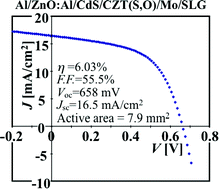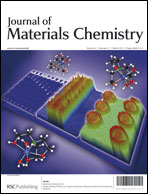An open atmosphere type chemical vapor deposition (OA-CVD) method is one of the most effective methods for producing functional thin films. Especially, the OA-CVD method is a unique technique which is able to deposit metal oxide thin films by decomposition of vaporized raw materials released through a nozzle onto substrates in the air. Cu2ZnSnS4 (CZTS)-based thin films as absorber layers of thin film solar cells were fabricated by sulfurizing oxide precursor thin films synthesized by the OA-CVD method. Cu(C5H7O2)2, Zn(C5H7O2)2 and Sn(C5H7O2)2 were used as raw materials. The oxide precursor thin films were sulfurized at 520–560 °C in 5 vol% H2S balanced with N2. The formed CZTS-based thin films included oxygen with the composition ratio of O/(S + O) = 0.17–0.27 according to energy dispersive X-ray spectroscopy. The thin film solar cells using the CZTS-based thin films including oxygen [CZT(S,O) films] as the absorber layers were fabricated. The CZT(S,O) thin film solar cell had a stack structure of Al/Al-doped-ZnO/CdS/CZT(S,O)/Mo/soda-lime glass substrate. The efficiency of the CZT(S,O) thin film solar cells was 6.03%, which was the high efficiency in the reported value for CZTS-based thin film solar cells using oxide thin film precursors. It was found that the OA-CVD method is suited to fabricate the absorber layers of thin film solar cells.

You have access to this article
 Please wait while we load your content...
Something went wrong. Try again?
Please wait while we load your content...
Something went wrong. Try again?


 Please wait while we load your content...
Please wait while we load your content...